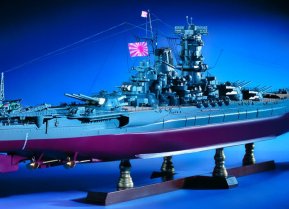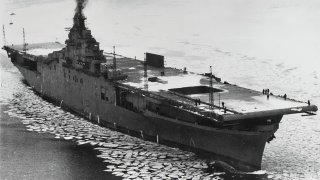U.S. Navy Aircraft Carrier USS Lexington (CV-16) Was a Masterpiece
The USS Lexington (CV-16), an Essex-class aircraft carrier, played a crucial role in World War II after being commissioned in 1943. Initially named Cabot, it was renamed to honor the sunk USS Lexington (CV-2). Engaging in pivotal battles across the Pacific, from Tarawa and Wake Island raids to the decisive Battle of Leyte Gulf, the Lexington significantly impacted the war's outcome.
Summary: The USS Lexington (CV-16), an Essex-class aircraft carrier, played a crucial role in World War II after being commissioned in 1943. Initially named Cabot, it was renamed to honor the sunk USS Lexington (CV-2). Engaging in pivotal battles across the Pacific, from Tarawa and Wake Island raids to the decisive Battle of Leyte Gulf, the Lexington significantly impacted the war's outcome. Decommissioned in 1947, it was modernized and recommissioned in 1955, serving through Vietnam and training naval aviators until 1991. Today, it stands as a museum in Corpus Christi, Texas, preserving its legacy as a symbol of American naval power.
Introducing the Aircraft Carrier USS Lexington (CV-16)
The USS Lexington (CV-16) was an Essex-class aircraft carrier that served a vital role in America’s most dramatic international conflict: World War II. First commissioned in 1943, the Lexington mobilized immediately to help America advance across the Pacific, and into the heart of Imperial Japan.
The Lexington was initially laid down as the Cabot, in July 1941, at the Fore River Shipyard in Quincy Massachusetts. But the name was changed after the May 1942 sinking of the USS Lexington (CV-2) at the Battle of the Coral Sea. Following CV-2’s sinking, workers at the Fore River Shipyard submitted a request to Navy Secretary Frank Knox to change the Cabot to the Lexington. Knox agreed, and the Cabot was renamed the Lexington – becoming the fifth US Navy vessel to bear the name of the Revolutionary War’s Battle of Lexington.
Mrs. Theodore Douglas Robinson sponsored the Lexington as the vessel was launched in September 1942. The Lexington was commissioned in February 1943, with Captain Felix Stump in command. The Navy’s brand-new carrier was initiated with a shakedown cruise in the Caribbean before cutting through the Panama Canal to join the Pacific fleet. But before the Lexington ever made it to the Pacific, she suffered one of her first (and highest profile) casualties.
Nile Kinnick was the 1939 Heisman Trophy winner and a naval aviator training aboard the Lexington during the ship’s shakedown cruise. Kinnick’s Grumman F4F Wildcat developed an oil leak and was unable to land safely aboard the Lexington, crashing four miles away. Neither Kinnick nor his Wildcat were ever recovered.
Entering the Second World War
The Lexington arrived in Pearl Harbor on August 9th, 1943, and soon thereafter began participating in the ongoing war. The first actions that the Lexington engaged in were a raid on Tarawa air bases and a raid against Wake Island. The vessel also flew sorties in the Marshall Island chain, and covered landings in the Gilbert Islands. Lexington-based aviators shot down 29 Japanese aircraft on November 23rd and 24th alone.
In December 1943, Lexington participated in the raid upon Kwajalein. Aviators from the Lexington destroyed the SS Kembu Maru, damaged two Japanese cruisers, and shot down 30 aircraft.
A torpedo struck the Lexington at Kwajalein. The starboard impact disabled the vessel’s steering gear and killed nine sailors. Damage control crews scrambled to weld shut damaged compartments and a hand-controlled steering method was devised, allowing the Lexington to limp back to Pearl Harbor for emergency repairs, and finally, for Bremerton, Washington where she underwent full repairs.
Making a difference
Returning to action, the Lexington participated in multiple high-profile engagements. In the Battle of the Philippine Sea and what has come to be referred to as the “Great Marianas Turkey Shoot,” in which US naval aviators destroyed over 300 enemy aircraft, one carrier, one tanker, and one destroyer. The loss was catastrophic to the Japanese in that, not only were 300 aircraft destroyed, but so too were 300 aviators lost – hindering Japan’s aerial capabilities for the rest of the war.
The Lexington also participated in the Battle of the Leyte Gulf, which is considered the climactic naval victory over Japan. Aircraft from the Lexington performed admirably, sinking the Musashi, Chitose, Zuikaku, and Zuiho.
The final involvement for the Lexington during World War II, was joining Rear Admiral Thomas L. Sprague’s task force. The task force hammered the Japanese home islands with airstrikes, from July to August 1945, towards the final days of the war. The Lexington launched strikes against Honshu and Hokkaido airfields and Yokosuka and Kure naval bases, helping to destroy the remnants of the Japanese fleet. During the raid, Lexington-based aircraft sank the Ise.
As the war concluded, aircraft from the Lexington continued to fly air patrols over the Japanese island.
After the war
Lexington was decommissioned in 1947, but that would not be the end of her service. In 1955, Lexington was recommissioned after being retrofitted with an angled flight deck, steam catapults, a new island, and a hurricane bow. The retrofits allowed the Lexington to operate modern aircraft – which had progressed significantly in the decade since the end of World War II.
Remarkably, the Lexington would serve for another three and a half decades. The already storied Lexington added to her legacy, launching air operations over Vietnam, and helping to train another generation’s worth of naval aviators. Decommissioned for good in 1991, the Lexington still floats today, as a museum in Corpus Christi, Texas.
About the Author: Harrison Kass
Harrison Kass is a defense and national security writer with over 1,000 total pieces on issues involving global affairs. An attorney, pilot, guitarist, and minor pro hockey player, Harrison joined the US Air Force as a Pilot Trainee but was medically discharged. Harrison holds a BA from Lake Forest College, a JD from the University of Oregon, and an MA from New York University. Harrison listens to Dokken.


